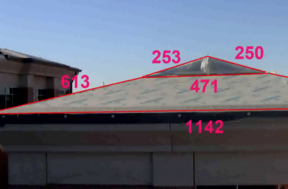Say you’re a 3D data acquisition pro (and likely you are, if you’re reading this). Is there a quote that makes your mouth water more than this one? “We have a machine that reads CAD models, or BIM, and cuts panels to fit them,” says Geoffrey Stone, Metalforming’s CEO. But, he says, “we can’t cut metal panels to as-drawn BIM files because it’s not accurate enough. We need as-built.”
I mean, no kidding! However, this guy is not using a laser scanner to solve his problem. As outlined in this ENR story (apparently cut and pasted onto the Georgia Tech web site, where I found it), Metalforming is part of an innovative trial using a videogrammetry device that the Georgia Institute of Technology has created, which puts a pair of cameras on the end of a pole that can then be extended to grab video of the roof. The device sends data back to a server, the server does the math, and then the measurement information is sent to an automated roof panel forming and cutting machine. Apparently, the accuracy is within 15 mm for anything being measured within about 20 meters.
Boom. There you have your pre-fab pieces. You’ve saved time in the measuring, material in the accurate cutting, time in the installation that doesn’t need any adjustments, and all of that means saved money. That’s what 3D data is supposed to do.
Oh, and GIT thinks they’ll have this device and its accompanying software on the market by this summer. For a grand total of about $1,000. That seems like a pretty small investment with a pretty rapid ROI.
Sure, this took five years of research and a bunch of grant money to figure out, but it seems like time and money well spent if this quote is true:
Stone says no other existing measurement technology—including satellite imaging, phase-shifting lasers or total stations—is accurate, inexpensive and straightforward enough to be a reasonable alternative for roofing companies to use to get precise roof measurements. “We wanted something simple, cheap and accurate,” he says.
Of course, this is a very specific application, but that’s a good thing. As the market and technology matures, we should expect to see solutions to very specific problems popping up, especially if they’re at reasonable prices. GIT hasn’t created a device for every measurement problem, just the one these roofers were experiencing, but that may be good enough to build a business.






